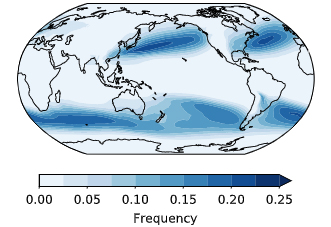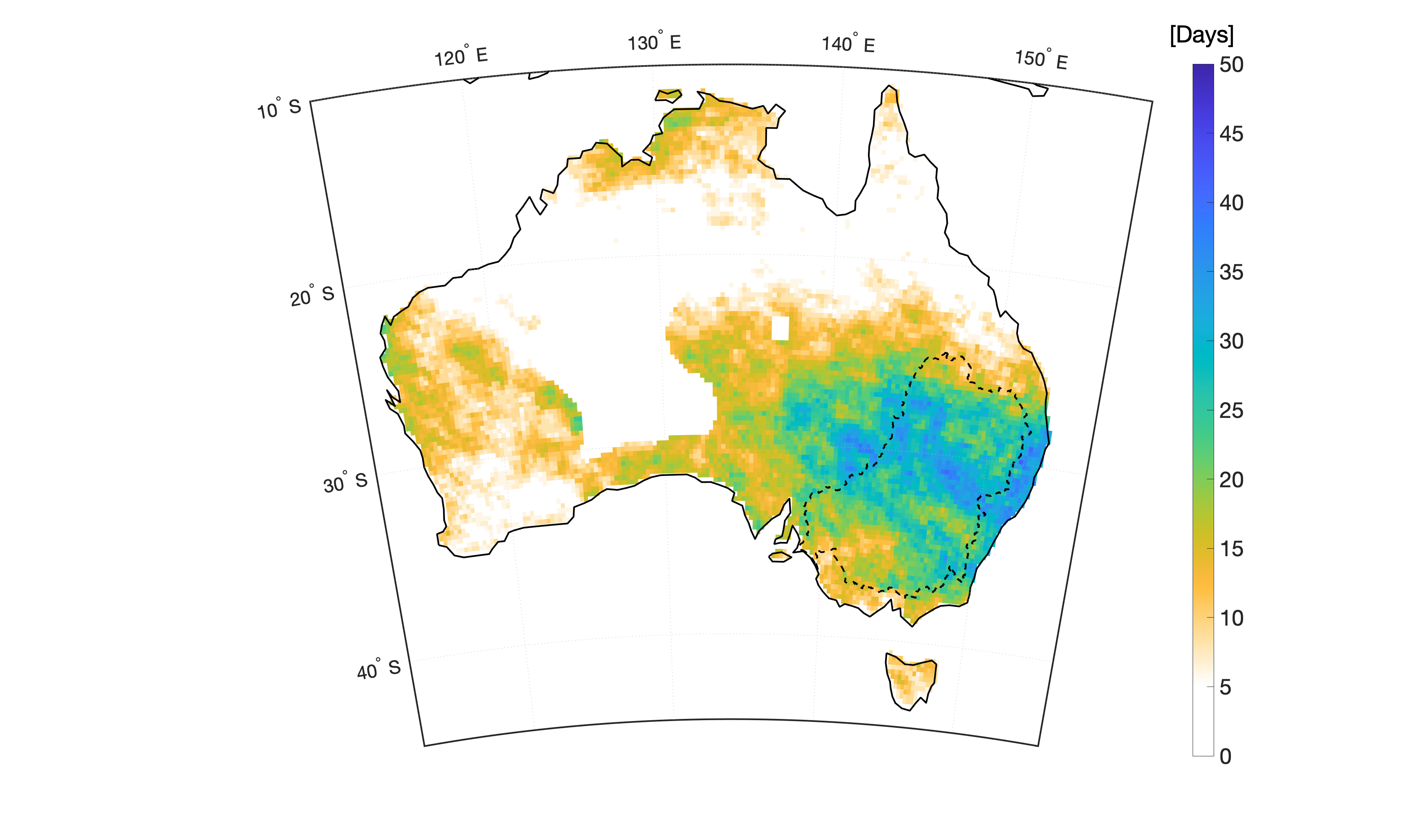
- Atmospheric rivers are regions of strong atmospheric moisture transport in the lower atmosphere
- Atmospheric rivers contribute 20-35% of southeast Australia’s and 10-20% of southwest Australia’s annual rainfall
- Atmospheric rivers can be disastrous, contributing to the heavy rainfall and flooding in February-March 2022 in Eastern Australia
- The Centre’s research indicates that Sydney will experience more frequent intense atmospheric river events by the end of the 21st Century, due to climate change
What are atmospheric rivers?

Atmospheric rivers are streams of moist air in the lowest one to three kilometres of the atmosphere that are a key mechanism for transporting water vapour around the globe. In the Australian region, atmospheric rivers are most often found to the south of the continent (Figure 1), but they can manifest over other regions of Australia. They are at least 2000 kilometres long, and there are typically five or six on the globe at any one time. Atmospheric rivers are most commonly found ahead of cold fronts in the mid-latitude storm tracks (Figure 1). They are also found in the tropics off the northwest and northeast coasts of Australia. The most intense atmospheric rivers near Australia form over the Coral Sea region.
How do atmospheric rivers affect Australia?
Generally, atmospheric rivers bring beneficial rainfall to Australia. On average, atmospheric rivers contribute 20-35% of southeast Australia’s and 10-20% of southwest Australia’s annual rainfall. Of the 100 wettest rainfall days in the northern Murray-Darling Basin region between 1980-2019, approximately 30-40 occurred during an atmospheric river event (Figure 2). Strong atmospheric rivers can help break droughts. For example, an atmospheric river contributed to wet weather in May 2022 which helped break droughts in Queensland.
However, they can also contribute to widespread heavy rainfall and flooding. For example, between the 17th and 24th of March 2021, eastern Australia experienced record-breaking rainfall and widespread flooding. More than 400mm of rain fell in some locations and it is estimated that insured losses amounted to $652 million. The intense rain was associated with a confluence of moisture in the atmosphere from two different sources. An atmospheric river transported moisture from the Indian Ocean from the northwest to the east coast. In addition, a high-pressure system in the Tasman Sea pushed moist air over the coast from the east. This led to the convergence of two moisture laden air masses over eastern Australia (see Figure 3). More recently, atmospheric river activity has contributed to the February-March 2022 floods in eastern Australia when a blocking high pressure system allowed an atmospheric river to persist over southeast Queensland and northern NSW. Combined with a low-pressure region over NSW, this combination of weather systems led to devastating floods.

How are atmospheric rivers affected by climate variability?
Like other aspects of Australia’s weather, atmospheric rivers can be affected by variability in conditions over the tropical oceans and this is a subject of recent research by the ARC Centre of Excellence for Climate Extremes and the Bureau of Meteorology. During La Niña periods, when the central and east tropical Pacific is unusually cool and the ocean to the north of Australia is warmer than normal, atmospheric rivers are more likely to form at tropical and subtropical latitudes. Atmospheric rivers are less likely to form during El Niño events, when the central and east tropical Pacific is unusually warm and the ocean around Australia is relatively cooler. Similarly, during the negative phase of the Indian Ocean Dipole, which is associated with cooling of the western tropical Indian Ocean and warming of the east, atmospheric rivers are more likely to occur off the northeast and northwest coast of Australia. Atmospheric rivers are less likely during the positive phase of the Indian Ocean Dipole, with warming of the western tropical Indian Ocean and cooling of the east. The frequency of atmospheric river formation over the Southern Ocean south of Australia tends to not be affected much by these tropical influences. Australia has experienced the effects of back-to-back La Niña events with a 50% chance of a third La Niña event developing later this year.

How might atmospheric rivers change in the future?
It is likely that atmospheric rivers will increase in frequency, due to climate change, with variation between different regions. In the Southern Hemisphere, atmospheric rivers are expected to shift south with climate change as a result of a southward shift in the Southern Hemisphere jet stream, a narrow band of high winds in the upper atmosphere that steers weather systems over the Southern Ocean. Additionally, the expansion of the tropics means we expect to see more frequent intense atmospheric rivers over southern Australia. However, more research is required to be able to assess the size and exact location of the effect.
Recent research led by the ARC Centre of Excellence for Climate Extremes in collaboration with Indiana University and the Lawrence Berkeley National Laboratory in the US found it is likely that we will see a higher occurrence of atmospheric rivers in the Sydney region with climate change, increasing the risk of heavy rainfall and flooding. The research analysed climate model simulations of two scenarios (SSP5-8.5 and SSP2-4.59) with different assumptions about future greenhouse gas emissions and associated degree of global warming.
These scenarios resulted in 3.3-5.7°C and 2.1-3.5°C warming above pre-industrial temperatures by the end of the 21st century. Climate model simulations suggest that the likelihood of atmospheric rivers that transported similar amounts of water vapour as during the March 2021 east Australia floods, increased in the simulations by about 80% over Sydney by 2080-2100 under both scenarios.
Moreover, consecutive days of high-water vapour transport over Sydney are projected to increase by 40% by 2080-2100 under both scenarios.
It is important to note that these are climate model projections and indicate a possible future. It is also currently uncertain how the frequency of longer duration transport events (e.g. more than three days in a row) will behave in a warmer world. Overall, this means that climate models suggest that the likelihood of extreme rainfall will increase over Sydney by the end of this century. However, more work is required to address climate model uncertainties, and to fully understand the potential impacts of this projection and understand changes in atmospheric rivers elsewhere in Australia.
How can we reduce the risks posed by atmospheric rivers?
There are many ways that the adverse impacts of extreme rainfall from atmospheric rivers can be mitigated. One of these is the provision of reliable forecasts further in advance.
Currently, the ARC Centre of Excellence for Climate Extremes in collaboration with the Bureau of Meteorology is conducting research to determine if we can forecast changes in the probability of extreme rainfall events associated with atmospheric rivers 2-6 weeks ahead, using our understanding of the large-scale movement of water vapour around the globe.
The goal would be to provide longer lead times for emergency managers, but also potentially increase flood mitigation by creating additional storage in dams.
Briefing note created by Dr Kimberley Reid.
